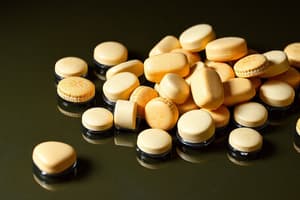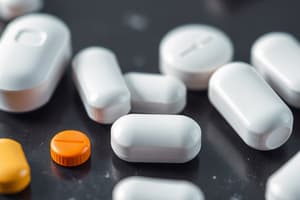Podcast
Questions and Answers
What is the primary mechanism by which aspirin exerts its anti-inflammatory effects?
What is the primary mechanism by which aspirin exerts its anti-inflammatory effects?
- Reversibly inhibiting the cyclooxygenase (COX) enzyme.
- Irreversibly acetylating and inactivating the cyclooxygenase (COX) enzyme. (correct)
- Increasing the synthesis of prostaglandins and thromboxanes.
- Stimulating the production of lipocortin.
Which of the following is a selective COX-2 inhibitor?
Which of the following is a selective COX-2 inhibitor?
- Indomethacin
- Ibuprofen
- Celecoxib (correct)
- Aspirin
What is the primary reason low doses of aspirin are used in the prophylaxis of myocardial infarction?
What is the primary reason low doses of aspirin are used in the prophylaxis of myocardial infarction?
- To increase the synthesis of prostacyclin (PGI2) in platelets.
- To reduce inflammation in the coronary arteries.
- To selectively inhibit thromboxane A2 (TXA2) synthesis in platelets, preventing platelet aggregation. (correct)
- To increase the production of nitric oxide in the endothelium.
Which of the following best describes the mechanism by which NSAIDs can lead to renal vasoconstriction?
Which of the following best describes the mechanism by which NSAIDs can lead to renal vasoconstriction?
How does aspirin affect uric acid excretion at low doses (1-2 g/day)?
How does aspirin affect uric acid excretion at low doses (1-2 g/day)?
Which of the following is an accurate description of the effects of acetaminophen?
Which of the following is an accurate description of the effects of acetaminophen?
What is the primary mechanism of action of NSAIDs concerning prostaglandin synthesis?
What is the primary mechanism of action of NSAIDs concerning prostaglandin synthesis?
Why are selective COX-2 inhibitors sometimes preferred over non-selective NSAIDs?
Why are selective COX-2 inhibitors sometimes preferred over non-selective NSAIDs?
Which of the following best explains why aspirin is contraindicated in children with viral infections?
Which of the following best explains why aspirin is contraindicated in children with viral infections?
Which of the following is NOT a typical clinical application of NSAIDs?
Which of the following is NOT a typical clinical application of NSAIDs?
In the context of NSAIDs, what is the role of phospholipase A2?
In the context of NSAIDs, what is the role of phospholipase A2?
Which statement accurately describes how aspirin interacts with other drugs?
Which statement accurately describes how aspirin interacts with other drugs?
A patient taking NSAIDs develops heartburn and epigastric pain. Which approach would best prevent these GI side effects?
A patient taking NSAIDs develops heartburn and epigastric pain. Which approach would best prevent these GI side effects?
What is the primary role of cyclooxygenase (COX) in the inflammatory process?
What is the primary role of cyclooxygenase (COX) in the inflammatory process?
Which of the following is a potential adverse effect associated with NSAID use, particularly in susceptible individuals?
Which of the following is a potential adverse effect associated with NSAID use, particularly in susceptible individuals?
How does aspirin's antiplatelet effect differ in platelets compared to endothelial cells?
How does aspirin's antiplatelet effect differ in platelets compared to endothelial cells?
What is the mechanism by which NSAIDs, including aspirin, can lead to gastrointestinal adverse effects?
What is the mechanism by which NSAIDs, including aspirin, can lead to gastrointestinal adverse effects?
Which of the following best describes the role of Misoprostol in preventing NSAID-induced gastric ulcers?
Which of the following best describes the role of Misoprostol in preventing NSAID-induced gastric ulcers?
What is the primary reason acute overdose of acetaminophen can lead to hepatotoxicity?
What is the primary reason acute overdose of acetaminophen can lead to hepatotoxicity?
Which of the following is the most accurate description of salicylism?
Which of the following is the most accurate description of salicylism?
Flashcards
What are NSAIDs?
What are NSAIDs?
Non-steroidal anti-inflammatory drugs. They inhibit cyclooxygenase (COX) enzymes, reducing the production of prostaglandins and thromboxanes.
What are Cyclooxygenases?
What are Cyclooxygenases?
Enzymes (COX-1 and COX-2) responsible for the production of prostaglandins and thromboxanes from arachidonic acid.
What is COX-1?
What is COX-1?
Constitutively expressed enzyme in many tissues, involved in maintaining normal physiological functions like gastric protection and platelet function.
What is COX-2?
What is COX-2?
Signup and view all the flashcards
How does Aspirin work?
How does Aspirin work?
Signup and view all the flashcards
How do NSAIDs work?
How do NSAIDs work?
Signup and view all the flashcards
What are the uses of NSAIDs?
What are the uses of NSAIDs?
Signup and view all the flashcards
What are the adverse effects of NSAIDs?
What are the adverse effects of NSAIDs?
Signup and view all the flashcards
How does Paracetamol work?
How does Paracetamol work?
Signup and view all the flashcards
What are the uses of Paracetamol?
What are the uses of Paracetamol?
Signup and view all the flashcards
What is the GI effect of NSAIDs?
What is the GI effect of NSAIDs?
Signup and view all the flashcards
How do NSAIDs affect platelets?
How do NSAIDs affect platelets?
Signup and view all the flashcards
Study Notes
Non-Steroidal Anti-Inflammatory Drugs (NSAIDs)
- NSAIDs are classified as COX-1 versus COX-2 inhibitors.
- Non-selective COX-1 and COX-2 inhibitors include aspirin, indomethacin (Indocid®), ibuprofen (Brufen®), ketoprofen (Profenid®, Ketofan®), piroxicam (Feldene®), diclofenac (Voltaren®, Cataflam®).
- Selective COX-2 inhibitors include celecoxib (Celebrex®).
Mechanism of Action
- Aspirin irreversibly acetylates (and thus inactivates) cyclooxygenase enzyme.
- Other NSAIDs are reversible inhibitors of the enzyme.
- This leads to decreased synthesis of PGs and TXA2.
Pharmacological Actions
- Anti-inflammatory effect: Reduced PGs mean reduced inflammation and reduced bradykinin.
- Analgesic effect: Reduced PGs peripherally at the site of inflammation and reduced pain pathways centrally at a subcortical site.
- Antipyretic effect: Decreased PGE2 in the hypothalamic thermoregulatory center resets the thermostat.
- Antiplatelet effect: Aspirin irreversibly inhibits COX in platelets, which lack a nucleus and cannot resynthesize the enzyme.
- In the endothelium, aspirin inhibits PGI2 synthesis, but the endothelium can synthesize new COX and PGI2 due to possessing a nucleus.
- Low doses of aspirin result in massive inhibition of TXA2 synthesis in platelets with little effect on endothelial PGI2 production, leading to reduced platelet aggregation.
- Gastrointestinal effects: Oral and parenteral NSAIDs produce GI adverse effects, ranging from heartburn to gastric and duodenal ulcers.
- This effect can be prevented by misoprostol, proton pump inhibitors (PPIs) such as omeprazole, and selective COX-2 inhibitors.
Renal function
- NSAIDs affect renal function.
Effect on Uric Acid Excretion
- Uric acid filtered in the glomeruli is actively reabsorbed and secreted again in the proximal tubules.
- Aspirin's effect on uric acid excretion is dose-dependent.
- Small doses of aspirin (1-2 g/day) decrease tubular secretion of uric acid, increasing plasma urate concentration.
- High doses of aspirin (> 5 g/day) decrease tubular reabsorption of uric acid, increasing uric acid excretion.
- Moderate doses of aspirin (2-3 g/day) do not alter uric acid excretion.
Clinical Uses of NSAIDs
- Anti-inflammatory use for musculoskeletal disorders like myositis, tendinitis, rheumatoid arthritis, osteoarthritis, and ankylosing spondylitis.
- Examples of dosages include aspirin (3-6 g/day), ketoprofen (200 mg/day), and piroxicam (20 mg/day).
- Analgesic use for low to moderate intensity pain, such as headache, dysmenorrhea, and dental pain.
- Antipyretic use in febrile states.
- Aspirin in low doses (75-325 mg/day) is used for prophylaxis from myocardial infarction and stroke in high-risk patients.
Adverse Effects and Precautions
- GI toxicity, which is not shared with selective COX-2 inhibitors.
- Increased bleeding tendency, especially with aspirin.
- Alteration of renal function in susceptible individuals.
- Hypersensitivity reactions, especially with aspirin (15%).
- Decreased uric acid excretion (increased uric acid in the blood) with low doses of aspirin.
- Reye's syndrome: Avoid using aspirin in viral infections in children.
- Salicylism: Symptoms include vomiting, tinnitus, vertigo, and decreased hearing.
Drug Interactions
- Aspirin enhances the activity of coumarin anticoagulants, sulfonylurea antidiabetic agents, methotrexate, phenytoin, and valproic acid by displacing them from plasma protein binding sites.
- Aspirin and other NSAIDs may reduce the antihypertensive effect of ACE inhibitors by interfering with bradykinin-facilitated PGs synthesis.
Paracetamol (=Acetaminophen)
- Paracetamol inhibits COX-3 in the brain but not at sites of inflammation.
- It is an analgesic and antipyretic without anti-inflammatory activity
- Paracetamol has no antiplatelet or ulcerogenic activity and does not affect uric acid excretion.
- Paracetamol can be safely administered during pregnancy.
- Acute overdosage causes hepatotoxicity.
Studying That Suits You
Use AI to generate personalized quizzes and flashcards to suit your learning preferences.





